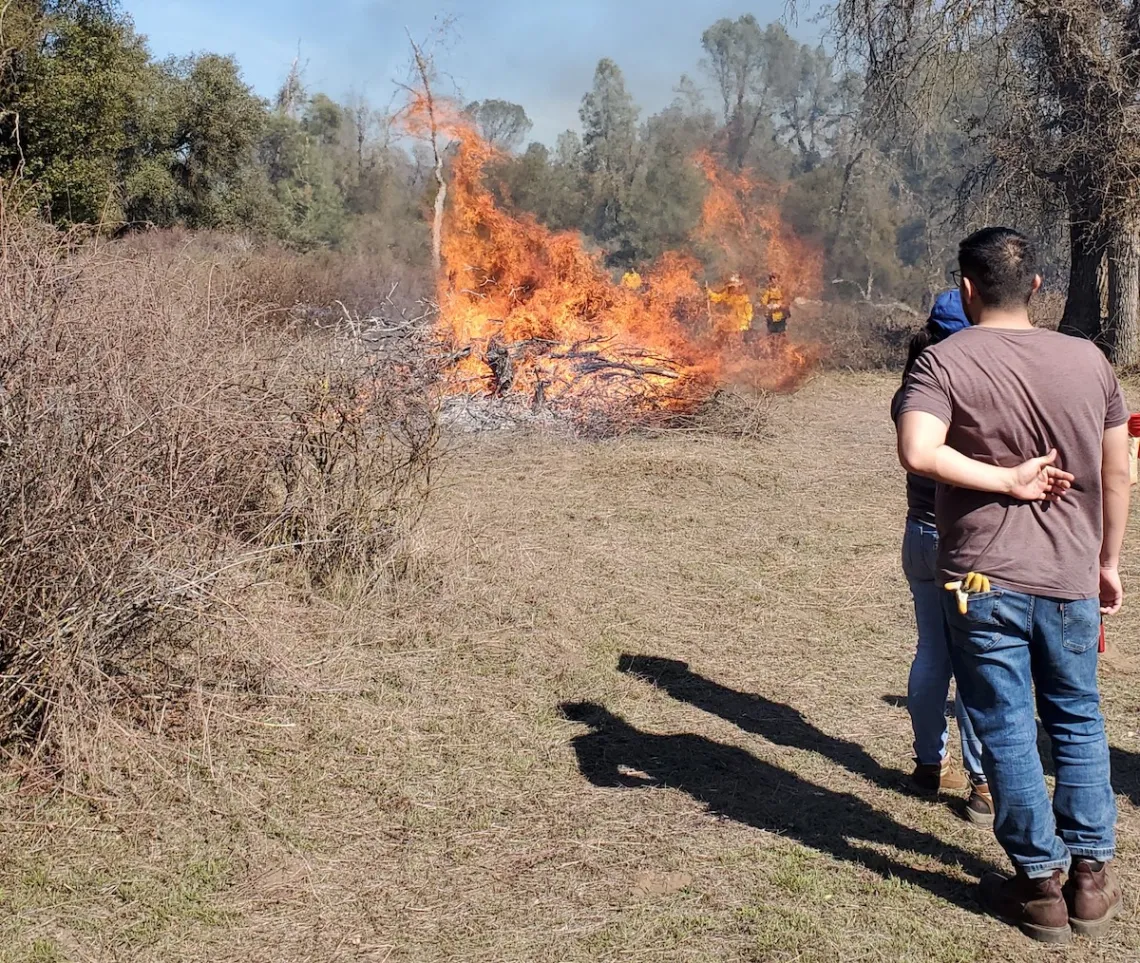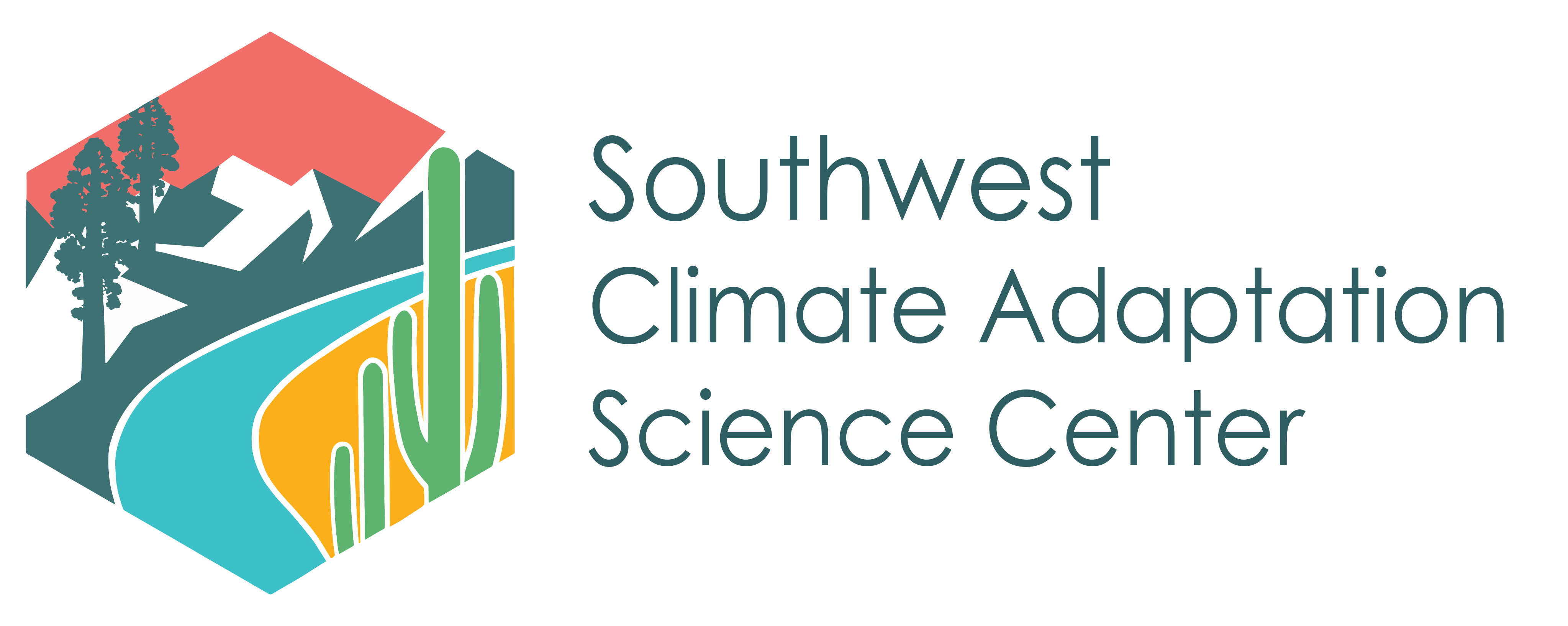Reflections on a Native American Cultural Burning Event

For many Native Nations, cultural identity and ways of life are directly tied to relationship with the land. Many tribes have long-established methods of land management and stewardship, including
using fire to maintain the health of ecosystems that tribal members rely on for their well-being. Members of the SW CASC were fortunate enough to participate in a traditional burning workshop, the
February 2020 Resource Restoration Cultural Burn in Mariposa, CA. The event was hosted by Ron Goode of the North Fork Mono Tribe and his family. Beth Rose Middleton, a professor at the University of California, Davis and a Principal Investigator for the SW CASC, also assisted in hosting and organizing the event. She was further supported by her graduate student advisees, Chris Adlam and Deniss Martinez in Ecology and Melinda Adams in Native American Studies. Over 70 people were invited, including members of the local and regional community, local and state officials, university affiliates, and members of the SW CASC.
I had the opportunity to speak with Anita Govert (SW CASC Assistant Director), Althea Walker (SW CASC Tribal Climate Adaptation Science Liaison), Dr. Beth Rose Middleton, Chris Adlam, and Deniss Martinez, about their experiences participating in this event. Answers have been edited for length and clarity.
Q: What were some important reasons why the SW CASC participated in this event.
Anita Govert explains "It was a great experience! In a way, I felt funny being asked to be a guest speaker. I was present to be "the student" of the traditional knowledge and practices involved in the cultural burning experience. " The entire weekend's interactions amongst the 70+ attendees was a very generous gift to me personally which opened me up to think more expansively about how the SWCASC can help resource managers in practical ways. I briefly presented a backdrop of the purpose and mission of the SW Climate Adaptation Science Center early on the opening day. Having been given that moment, the door was open for the participants to ask me questions throughout the event and become the human link to keep hearing those questions from students and resource managers.
Q: What exactly is Cultural Burning and why was this event so important?
According to Dr. Beth Rose Middleton we need to listen to the Indigenous weavers and fire practitioners, including Ron Goode (North Fork Mono), Julie Tex (Dunlap Mono), Gladys McKinney (Dunlap Mono), and Florence Dick (Dunalp Mono) who explained and demonstrated that if you don’t burn the plants you can’t weave materials from them, they have to be burned in order to come back with straight growth.” Burning the land also supports serotinous plants, or plants that need to be burned in order to seed, clears land for cultivation, and makes room for new growth. Beth Rose stresses that, “I have learned that we really need frequent low intensity burns to maintain the health of the forests.”
Althea Walker states that cultural burning allows the community to remain on healthy land. “It's a two-way street with the environment you know, as long as we keep giving ourselves to it, giving it the time that it needs, the attention that it needs, and continue to care for it, it will care for us. Cultural burning is spending your time on the land in a respectful way. And all of this, I think that's the significance of cultural burning; is that it is a continued practice of relationship building and reciprocity, that we're still on the land, that were still giving our self to the land, with the prayers that she’ll continue to provide for us.”
Chris Adlam explains that this event brought together students, tribal community members both local and non-local, other locals community members, fire departments and Cal Fire, state legislators and regulators including the air quality management districts. He further states that, “we had lots of people turnout. And I think that it was really successful because there's just a lot of demand right now for people to be able to understand what it looks like to have sort of a different relationship with fire; one that isn't based on fear and just trying to put fires out, but based on a relationship in which fire is seen as something positive and necessary.”
Q: What are some of the differences between cultural burning and prescribed fires?
Deniss Martinez elaborates on the differences between cultural burning and prescribed fires. She says it has to deal with who is lighting the fire and why. Cultural fires boost cultural resources like food, fibers, and medicine. In these instances, fire is seen as a relative. It's an expression of cultural sovereignty in a way that prescribed fire is more disconnected from one’s cultural identity. She also mentions that in some occasions these two communities of practitioners, Indigenous communities engaging in cultural burning and agencies that engage in prescribed burn, are working toward the same goal. For example, during prescribed fire training exchanges (TREX) led by Indigenous people and the Nature Conservancy, participants learn prescribed and cultural fire techniques. “I would also say that they're trying to work together in ways that are really important,” Martinez said.
Cultural burning and other traditional ecological practices are starting to be recognized and accepted by state and federal managers. It is important going forward that stakeholders do not engage in cultural appropriation, which is taking knowledge or resources out of a community without proper consent, recognition, and compensation. TREX is one example of how respectful knowledge exchange can occur.
Q: Going forward, how can managers ensure they are not appropriating Indigenous cultures?
Dr. Middleton explains that there are at least three elements that are key to beginning and maintaining relationships with tribes: 1) recognition, 2) respectful partnership, and 3) resources. Recognition is acknowledging that cultural burning is a management/stewardship strategy that works and has been working for hundreds of years. Indigenous peoples have fought to practice and keep cultural burning practices alive despite being criminalized for it. She says, “Recognition and respectful partnership were central goals of both of our workshops—the one in Mariposa and the one in the Tending and Gathering Garden at the Cache Creek Nature Preserve. We had a lot of different potential partners there—you know, people who were coming together who are adjacent land managers, from different institutions, different agencies, and different tribes—all coming together to think about how can we respectfully collaborate.” As one expression of recognition and respect, there should also be adequate resources (funding) to support Indigenous cultural practitioners and educators.
Walker, SW CASC Tribal Climate Adaptation Science Liaison, says that it starts with relationship building and that any work that you engage in, especially as university representatives, should be based on the need and the request from the tribal community itself. Relationships should be established beforehand, so that initiatives are led, inspired, and guided by the Indigenous peoples of the land.
Q: Where do we go from here?
Moving forward, Dr. Middleton emphasizes that recognition is key. “We know that people have been practicing these techniques for thousands of years even in the face of opposition, suppression. So now we’re in this moment of needing to deal with very dire climate predictions and there’s increased attention to Indigenous management as a sustainable, time tested, and locally focused approach that has adapted to climatic changes over time.” She wants to explore how increased recognition will lead to increased support specifically of Indigenous-led initiatives. She ends with, “I hope we can play more of a role in that through the university and the diverse grad students that I work with. How can we respectfully support and possibly contribute to these Tribally-led initiatives?”
Dr. Middleton teaches two California Indian Environmental Policy classes at UC Davis. She has also collaborated with three PhD students, Chris, Deniss, and Melinda, to create the new class “Keepers of
the Flame,” on the science and policy of cultural burning. If you would like to learn more about cultural burning and Ron Goode, working with tribal communities, and Dr. Middleton check out these links:
- Fighting Fire with Fire: Using Cultural Burning Practices
- Guidelines for Considering Traditional Knowledges in Climate Change Initiatives
- SW CASC hosted a webinar on Native American Cultural Burning on May 12th at 1-2 pm PDT. Dr. Middleton and Ron Goode shared their experiences with cultural burning and how this Traditional Native American practice improves ecosystem resilience. To view the recording of the webinar, click here.
- Dr. Middleton was recently featured in an NPR piece on Cultural Burning.

